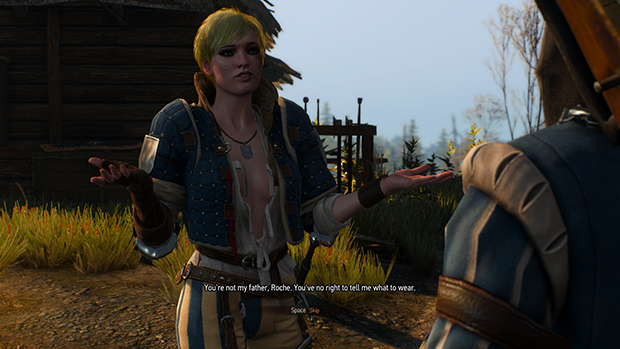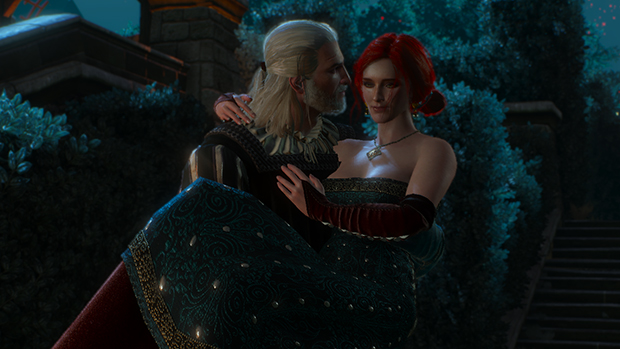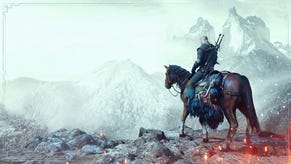The RPG Scrollbars: The Women Of The Witcher 3
Playing its cards right
One of the best things about The Witcher III is that it shows how far CD Projekt has come in just a few short years. We see it in world and quest design, in writing, in graphical technology and in scale, and all those speak for themselves. One of the biggest surprises though is how far it's climbed in terms of female representation over the years - from one of the industry's biggest targets to a high watermark others would be well advised to treat as the new baseline. It's not perfect, but it tries hard, and a game willing to do that is well worth taking a moment to praise for its success. There will be spoilers.
It's often surprising how games evolve, and which ones end up being a pleasant surprise. Saints Row IV is a great example. The earlier games are very stock GTA type stuff with an obsession with strippers and hookers, marketing campaigns featuring porn stars, and lots of other eye-rolling stuff - much of it to the developers' displeasure. By Saints Row IV though, the series had opened out considerably, allowing for much of the cast to be powerful, funny women who weren't simply welcomed in, but whose presence both in and at the top was simply treated as entirely natural and unworthy of mention. It doesn't matter if you're male or female, just that you're a Saint.
The Witcher III obviously has a much bigger cast to handle, but shares that sense of having finally achieved an understanding that it often lacked. Not exclusively, in both directions. It's still very fond of its sexy outfits for starters, and a few knowing comments about them being stupid only highlight that at least a few should probably have been changed. Ves in particular looks ridiculous walking into battle with pretty much little but a ripped shirt on, and while at least the sorceresses' magic spells can justify having it all hang out, it's impossible to defend a veteran soldier being so goddamn stupid.
What matters though isn't really the outfits, but the characters within them. As with many of The Witcher III's best bits, the real change started back in the second game, and Ves, somewhat depressingly given how she's portrayed in this one, was a great example. She's introduced as being desperate to win respect and be seen as more than - and I quote - 'tits atop an arse', and gets her chance in a duel with Geralt. The correct response of course isn't to throw the fight in the hope of helping her impress the men around her, but win, showing her the respect you'd shown those who came before her. It's a small moment in a game of many, many moments, but certainly a hell of a jump up from shagging someone to collect a porny little card to go on the pile.
The Witcher III regularly shows the same nuanced view of respect - respecting its female characters not simply by making them badass, but by making them interesting. That's as much a question of flaws as anything else - fleshing everyone out by having, to pick one, Geralt's former lover Yennefer often losing her careful cool over Geralt's various trysts with Triss, yet also fully able to both work and scheme with both towards a greater good. It allows for Triss to simultaneously express relief that Geralt's restored memory won't let people manipulate him any more, and cheerily confess to having done so herself on many occasions. It allows for the Bloody Baron's wife and daughter to be important characters with their own stories, both before and after Geralt arrives, rather than simply becoming emotional props to tell his story. His daughter Tamara in particular isn't simply sitting around and waiting for a hero to show up and sort out her problems - she's recruited allies, she's prepared, she's in the middle of trying to make things right herself. She's also accepted the price for all this in a way that Geralt as a main character will never have to either consider or pay.
And the list goes on. The Witcher III has been getting a bit of flack recently for its all-white cast, and I'm not planning to get into that one here, but in terms of female representation it's genuinely refreshing. Women can be elected queens reigning in wisdom over a manly land. They can be spiteful villagers who will call a barmaid a cunt and repeatedly smash her head into the bar. And anything in the middle - villagers, sorceresses, poets, princesses. That's of course before we even get to Ciri, a princess who only needs protecting because the scale of the foes chasing her is enough to terrify even a coalition of the world's most badass people, and even so has a destiny involving something on a scale that leaves them so powerless, they're not even in the loop on it.
Just as importantly, and often overlooked, most of them are genuinely fun characters in their own right - not suffering from the Lola Bunny problem, where the writer is so worried trying to make a 'perfect' character that they fail to make them interesting. So many moments stand out, from Yennefer being drawn into a werewolf themed pun war with Geralt to a certain character in Novigrad refusing to be conveniently stuffed into a fridge for the sake of drama - a terrible thing happens that I won't spoil, save to note that her response is a positive "Very well, if I can no longer X, I'll Y!"
This all also extends to The Witcher III's approach to sex, which does a decent job of treating both participants as partners in the act rather than the lady as a prize to be won. The first possibility that most players are likely to encounter, Keira Metz, is a good example, where she's the one who brings up the idea, handles all of the preparations, and has a wider plan in mind for the one-night stand. Later, the love triangle has a particularly funny outcome if Geralt mistakenly thinks that two ferociously smart, powerful sorceresses are going to let him keep both of them hanging.
An equally interesting element though is how both of them consistently have bigger priorities than his cock, with their primary focus really being on helping Ciri - a daughter/sister with whom they have as much history and emotional connection to. Instead of destructively chasing after Geralt and letting their friendship turn into animosity, they're also perfectly capable of recognising when he's gone from reasonably being torn between them and their histories to just plain dicking about.
All of this writing also manages to feel natural. There's nothing as pointed as, for instance, Dragon Age: Inquisition's scene about transgender soldier Krem or Dorian finally facing his father about his homosexuality - both very strong scenes, and in the case of the former especially, well worth including. I'm not arguing against their inclusion, simply comparing the styles. The Witcher III offers a far more realistic and grounded take on things that Bioware would normally give a PSA feel to, whether dealing with big picture issues or smaller ones, like not playing a crossdressing tailor for laughs or mocking his personal philosophy, but still letting him have a spark - not least having him be the one to share the alchemist Kalkstein's death by fire, complete with Agnes Nutter style fireworks display designed to spray out the words "Radovid sucks flaccid cock."
Throughout, sex, power, conflict, love, destiny and everything else that makes the characters more than just pixels on the screen are treated as part of the characters rather than their defining and only characteristic. It gives them grounded nuance, a life and agency beyond Geralt or the player's needs, whims or desires, as well as making it seem entirely appropriate when they work against him or leave him in the dark. They're in your story, but you're also in theirs, and they've not just been sitting around waiting for a map with a mop for his hair to show up and bless them with purpose.
One of Triss' scenes in particular stood out for me here. She's willing to volunteer for torture and humiliation at the hands of mage-hating witch hunters if it will help Geralt find Ciri, and duly suffers for it. As Geralt politely talks, we hear her screams as they rip her fingernails out with pliars. What's interesting about the scene though is the duality of what follows - her lash-back both a display of strength, that she is and always was powerful enough to stop the torture any time she wanted, and weakness in that she knows her inability to endure it could have thrown away any chance of finding her adopted sister. It's a wonderfully tight bit of writing in a game that makes it look so natural and easy, especially since on the surface it can so easily be mistaken for just a bit of torture porn.
The skill with with The Witcher III does all this is all the more impressive for the fact that it sits comfortably next to so much stuff that might otherwise start feeling icky - the constant hookers and strumpets for instance, or at least a couple of villains whose evil is shown using the Tortured Naked Lady School of Exposition. Occasionally something does go a bit too far, like the Ves thing, but generally every side simply feels like its own thread of an overall coherent tapestry - a world with room for every kind of person, be they good or evil, male or female, badass or victim, chaste and virginal or down to fuck on a stuffed unicorn. That doesn't simply make it a more realistic world, but an endlessly more interesting one - one to explore, to enjoy, and of course, to save.
And if you do still want pretty ladies on cards, hey, at least there's always Gwent.














